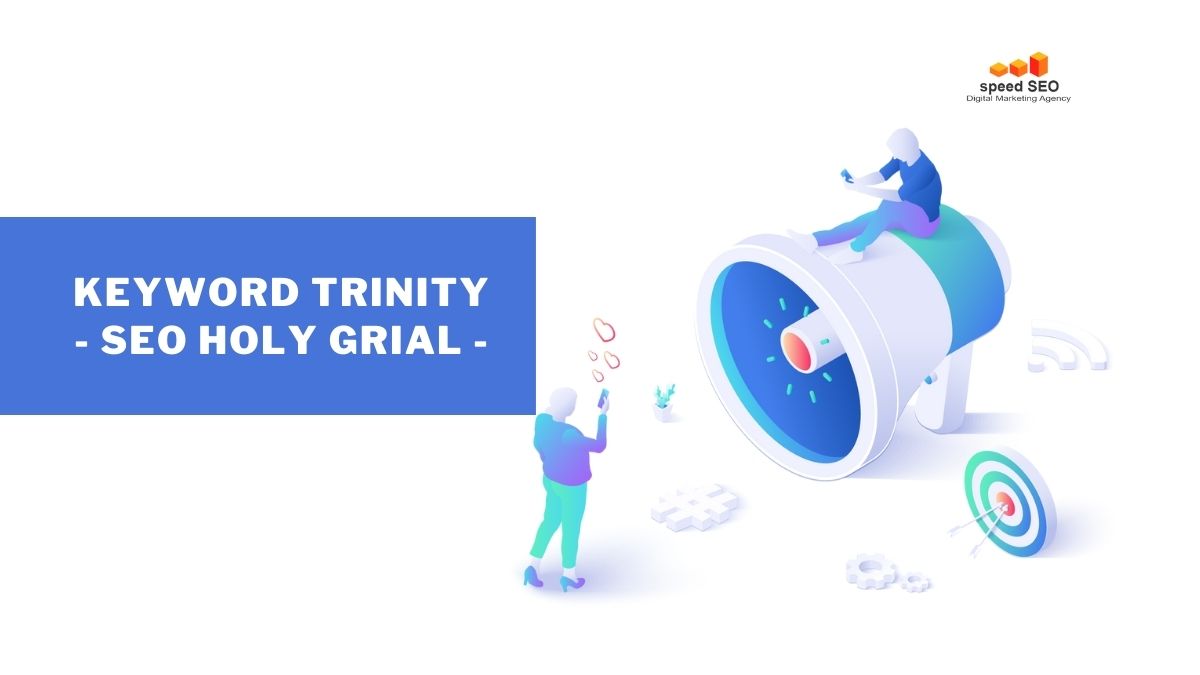In the beginning was the internet, and the internet was made of words, and the words were keywords. The same were what the internet needed.
Have you ever heard of the keyword trinity?

If not, don’t panic – Essentially, the keyword trinity is a strategy that seeks low competition keywords with high traffic and a clear search intent.
In other words, when people type these keywords into a search engine, they tend to actually find what they are looking for instead of just browsing endlessly.
This makes them more likely to engage with your website, which can translate into higher converting keywords and better SEO results overall.
When properly understood and implemented, this powerful trinity can be a game changer for SEO results.
Yes, this article will be all about you understanding the anatomy of a keyword, the holy grail of SEO. First, let’s start by defining what precisely a keyword is.
What is a keyword?
At its most basic level, a keyword is simply a word or phrase that people use to search for information online.
These keywords can be grouped into three main categories: head keywords, long tail keywords, and local keywords.
Head keywords:
These keywords are typically general search terms that cover a broad topic.
Because they have high search volume and tend to be very competitive, head keywords are usually difficult for most SEOs to rank well for.
However, with proper keyword research and targeting, it is possible to secure some top rankings for these terms.
Long tail keywords:
These keywords are much more specific, often targeted to a certain product or service.
While they may not have high search volume, long tail keywords are still valuable because they tend to convert much better than their head keyword counterparts.
Because these terms are typically less competitive, they can be easier to rank well for and yield more targeted results.
Local keywords:
These keywords are used by people looking for local businesses or services. Like long tail keywords, local keywords are often very specific and can be used to target a certain location.
Because they are geographically targeted, they tend to have higher conversion rates than head or long tail keywords.
And all of this is good and very good.
But did you know that when it comes to keywords, there are the 3 most important metrics you should pay attention to? It’s not all the metrics of a keyword, but these three are certainly the most important.
Let’s take a look at these Keyword Trinity Power Metrics.
What is keyword Trinity?
Each keyword has three indicators of strength: competition, traffic and intent.
If you don’t understand this trinity in a keyword you wont really be effective with your SEO strategies.
But worry ye not! We are here to bless you with the knowledge you need to understand the power behind a keyword well researched.
Keyword competition:
The first indicator is keyword competition, which measures how difficult it might be to rank well for a certain search term.
This can include assessing things like the backlinks and domain popularity of other websites that are ranking for that keyword or using various tools to measure competition level.
Keyword Traffic:
The second indicator is traffic volume, which shows how many people are searching for a particular keyword each month.
This can help you understand which keywords have the most potential to generate traffic to your website and bring in more revenue.
Keyword Intent
The final indicator is keyword intent, which measures what people are actually looking for when they type a given search.
This is a golden rule, you need to be able to skillfully understand what exactly people are looking for when they type in a certain keyword, and be able to position your content accordingly.
So if you want to master the art of SEO and grow your business online, it’s crucial that you understand how important the keyword trinity really is. Because with this knowledge, you can truly unlock the power of SEO!
If you’re willing to put some effort into understanding this trinity, it’s invaluable to your long-term success! And who wouldn’t want that? 🙂 Go forth and raise!
How to find the right keywords for your website or blog?
Thinking about the perfect keyword for your website or blog is no fun – until it’s time to find one. Instead of tearing your hair out in frustration over keyword research, take it with humour and remember something: keyword trinity.
As the saying goes, the foundation of your website or blog should be a triad of Keyword Intent, Keyword Research and Keyword Optimisation.
First and foremost, you should think about exactly what you want to achieve with each keyword – this is the Keyword Intent.
Then you need to do keyword research – but here’s the fun part: if you feel overwhelmed with SEO terms and phrases, just follow your gut and make sure the keyword resonates well with your readers.
Don’t forget keyword optimisation: make sure your keywords appear in headlines, descriptions and page titles so that a search engine crawling your website or blog knows where to look for valuable content!
Finding the right keywords for an online project doesn’t have to be an intimidating process, as long as you apply the infamous keyword trinity. So go ahead, make your website or blog unique!
Tips on using keywords effectively in your content
The lifeblood of any written document is keywords. By their very nature, keywords should drip into your content like the perfect spice blend onto a succulent steak.
Although keywords are the essence of what adds flavor and structure to your content, they can easily overpower if used incorrectly; imagine taking a bite of your entree only to find you’ve been duped by an excess of chipotle chili powder!
That’s why it pays to become familiar with the basics of keywords in content – from keyword optimization and identifying long-tail keywords to finding creative ways to incorporate keywords without having to refer to them as such.
It may seem tedious, but when used properly keywords will undoubtedly work their magic and tantalize readers’ senses in just the right way.
Whether used directly in body text or as meta tags and titles, keywords offer an important component for SEO success.
So make sure you savor the taste when using keywords correctly; it could be the difference between having a lackluster meal or a five course masterwork that lingers on your palate long after its consumed!
Keeping these tips in mind next time you plan on creating content can help ensure that readers have an enjoyable experience without running afoul of keyword overload.
After all, nobody likes food that has too much pepper… unless they asked for it in the first place!
Now get out there and start adding some zest to your online content! Bon Appetit!
The benefits of targeting long-tail keywords
Using long-tail keywords may seem like a daunting undertaking, but when done right, it can be the key to successful digital marketing.
Long-tail keywords are specific search terms that are more likely to be searched for by potential prospects or customers further down the sales funnel
They’re an important tool to place your brand with the right target groups at the right time. Targeting long-tail keywords also means that your brand is more visible in search results, because long-tail keywords are much less competitive than general terms
So if you’re thinking about how to make sure your message resonates with your target audience, consider long-tail keywords!
This may be difficult at first, but apart from being great for SEO purposes, long-tail keywords can also make your content unique and interesting – and maybe even raise a smile! Guaranteed to add some “humour” to your marketing strategy.
And who doesn’t need a little humour? In short, long-tail keywords aren’t only a smart choice for businesses looking to increase their visibility, but they’re also just plain funny! #Win!
How to track your progress with keyword rankings over time?
Looking for keyword rankings may feel like searching for a needle in a haystack – but that doesn’t mean it isn’t worthwhile!
Knowing how your keyword rankings are changing over time gives you powerful insights into where you should focus online marketing efforts to get the best results.
The key is to set up a tracking system to monitor keyword rankings on a regular basis, so that you can easily compare progress over time.
This could be as simple as manually checking keyword rankings each day or week, or more sophisticated by using an automated keyword tracking tool.
However, be warned -the pursuit of keyword ranking gains can become addictive, and the higher up the search engine rankings we go, the harder it gets!
Fortunately though, with each accomplishment comes bravado and satisfaction (not to mention likes, shares and comments!).
So go forth and get tracking – who knows where your keyword rankings will take you?
Wrapping things up!
Now that you understand the keyword trinity and how to find, use, and track keywords effectively, it’s time to take action.
If your website or blog’s organic traffic isn’t where you want it to be, don’t despair.
We can help turn things around with a comprehensive SEO plan that includes targeting the right keywords for your business.
Just leave us a comment below and we’ll be in touch!





